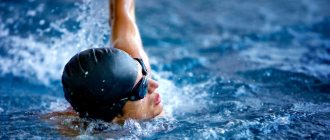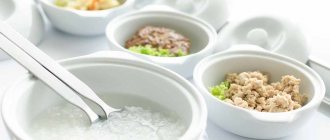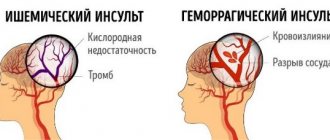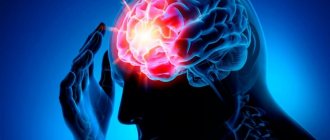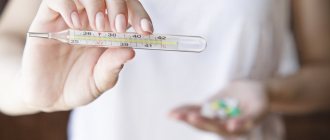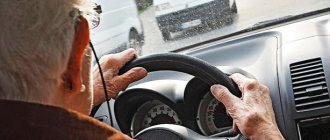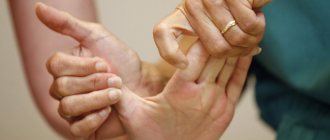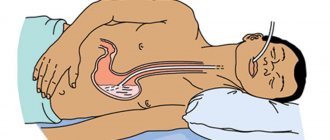Cognitive processes
There are three types of cognitive impairment after a stroke:
- Damage to one of the cognitive functions: memory (amnesia), the ability to perform any actions (apraxia), impairment of visual, auditory, tactile perception (agnosia).
- Violation of several functions that generally do not affect social adaptation.
- Multiple injuries that lead to social maladaptation: impaired attention, memory, volitional processes. In this case, post-stroke dementia is diagnosed. In older people with dementia, household activity decreases and self-care skills are lost. This category of patients is at risk of recurrent stroke.
The first and second variants of the disorder can be corrected due to the plasticity of the brain: damaged functions are compensated by functions that remain intact.
Rehabilitation of older people with post-stroke dementia includes sessions with psychologists. With the help of special exercises, patients develop auditory and visual memory, the ability to concentrate, and solve logical problems. The recovery process is accompanied by drug therapy.
General rules of care
The recovery period after a stroke is divided into early (up to 6 months), late (6-12 months) and residual effects (after 1 year). Ideally, in the early recovery period, the patient is recommended to be treated in palliative hospitals, sanatoriums, in the late recovery period and during the period of residual effects - in a day hospital, rehabilitation department, or by a visiting team at home. In reality, most often patients are at home after an acute period of stroke, and the main question that arises among their loved ones is where to begin rehabilitation. One of the main tasks of the rehabilitation process is to create comfortable conditions that promote relief and speedy recovery.
Preparing the premises
To exclude the impact of external traumatic factors (light, sound, temperature stimuli) on the patient’s psyche, he should be placed in a bright, well-ventilated room, where no extraneous noise can be heard from the street. The room should maintain a comfortable temperature within +18-22 °C.
The room should not be cluttered with furniture or objects that are easily moved out of place. A good alternative to a regular bed would be a functional one - with adjustable height and backrest position, side rails, and lockable wheels. Near the bed you need to place a bedside table with hygiene items, a blood pressure monitor, other necessary things, a wheelchair or other mobility aids (walkers, canes), a portable toilet or a bedpan.
If the person caring for the patient is not always with him, you can equip the room with a call button that the patient can easily reach, or replace it with a regular bell. Patients who can move independently or are beginning to train the skill of walking will find handrails along the walls very useful, and anti-slip mats in the bathroom will prevent injuries.
Body hygiene and bedsore prevention
Adequate prevention of bedsores can prevent their occurrence in 80% of cases.
Preventive measures:
- a special anti-bedsore or foam mattress with a thickness of at least 10 cm;
- soft bed linen without wrinkles;
- special cushions or pads made of foam rubber for vulnerable parts of the body (back of the head, shoulder blades, elbows, sacrum, heels, ankles);
- changing body position every 2-3 hours;
- comfortable underwear;
- prevention of skin trauma - carefully moving or turning over the patient.
It is important to carry out proper hygiene measures and skin care. At least once a day, during hygienic procedures, you should examine the entire surface of the patient’s body, vulnerable areas - every time you turn over. You should use waterproof diapers and diapers and change them as needed. It is necessary to wash the patient with warm water without soap after each bowel movement, washing with soap - no more than once a day, it is better to use liquid soap. After washing, the skin is thoroughly dried with a soft towel. For dry skin, moisturizing and nourishing creams are used; for diaper rash, powders without talc are used.
Nutrition
Food should be comfortable to swallow and easily digestible. The patient needs a sufficient amount of fluid - at least 1.5 liters. in the absence of restrictions. Drinking should not be limited even with urinary incontinence, since with a lack of fluid, urine becomes concentrated and irritates the skin.
The patient's diet should contain a sufficient amount of protein. It can be a soufflé, minced chicken, beef, rabbit, or fish. Patients who have difficulty chewing or swallowing semi-solid foods may be given meat or fish broth.
The menu should include dishes rich in vitamin C, iron, zinc, fermented milk products, fruits and vegetables.
Food is prepared boiled or baked and must be freshly prepared. You should not eat fried foods, pickles, smoked foods, spicy foods, canned food, fast food, carbonated and sweet drinks. You need to eat 4-5 times a day, in small portions.
First aid for a stroke: what to do before the doctor arrives
October 29 is World Stroke Day. For this reason, together with the doctor, we have compiled a detailed guide to first aid for a stroke and found out what should not be done under any circumstances
What is a stroke and why is it dangerous?
A stroke is a disorder of blood circulation in the brain. It can occur due to a ruptured vessel or blockage by a blood clot. In this case, the nerve cells do not receive the required amount of oxygen, glucose and other nutrients, which can lead to their death.
There are several factors that increase the risk of stroke, including: excess weight, high cholesterol, diabetes, hypertension, alcohol and drug use, and smoking. In addition, doctors take into account genetic predisposition and age: the disease most often affects those over 45 years old.
Stroke can be ischemic or hemorrhagic. Subarachnoid hemorrhage is also isolated, which is rare, but in 50% of cases is accompanied by death. He is characterized by acute pain in the back of the head, convulsions, vomiting and loss of consciousness are possible.
Ischemic stroke, or cerebral infarction, is the most common type of cerebrovascular accident. The immediate cause of ischemic stroke is blockage of a vessel supplying the brain. This may occur due to the formation of a blood clot or its entry into the lumen of the vessel. People with atherosclerosis, cardiac arrhythmias, or heart valve disease have an increased risk of developing blood clots. Ischemic stroke can occur when you take medications on your own without a doctor's prescription (for example, diuretics or combined oral contraceptives).
Symptoms of an ischemic stroke develop over a short period of time and are not accompanied by headaches, since there are no pain receptors in the brain. Most often this happens at night when a person is sleeping, and in the morning when waking up he discovers that an arm or leg is not working or speech is impaired.
In a hemorrhagic stroke, the wall of a vessel ruptures and blood permeates the brain tissue. Frequent causes of hemorrhagic stroke are increased blood pressure, taking drugs that reduce blood clotting, disruption of the structure of the vessel wall (aneurysm) or congenital anomalies of the vascular bed - arteriovenous malformations. Hemorrhagic stroke develops quickly and is often accompanied by headache. If blood soaks into the choroid of the brain, where there are pain receptors, a person may lose consciousness. This subtype of stroke has a high rate of death, but if the person survives, he recovers well.
First aid for stroke
It is advisable that a person with a stroke be taken to hospital as soon as possible - within three hours of the onset of the first symptoms. Therefore, it is important to properly organize assistance for a person with suspected stroke.
Call an ambulance. If you experience symptoms of a stroke, ask for help and have someone else call the doctor. Provide brief information about the patient (age, what happened). Leave your contact information so we can contact you. Be prepared to meet the physician and provide access to the patient.
Help the patient find a safe position: it is best to lie on his side with his head slightly elevated.
While you are waiting for an ambulance, try to find out from the patient when the symptoms began, what chronic diseases does he suffer from and what medications does he take? This information will save doctors time and allow them to quickly make decisions.
If a person is unconscious and not breathing, cardiopulmonary resuscitation must be performed. However, in order to provide it correctly, it is necessary to undergo specialized training courses.
If the patient has difficulty breathing, remove restrictive clothing (tight collar, tie or scarf) and open the windows.
— If a person is cold, cover him with a warm blanket.
— While the ambulance is traveling, do not under any circumstances try to give the patient something to drink, feed, or force him to stand up. The person may have difficulty swallowing and may choke. And when trying to stand up due to high blood pressure or lack of coordination, there is a high risk of falling and receiving additional injuries.
- Monitor the person closely for any changes in their condition. Be prepared to tell the emergency operator or doctor about their symptoms and when they started. Be sure to indicate whether the person fell or hit their head.
— In some cases, it is advisable to transport the patient to the nearest hospital yourself if you are not confident in the efficiency of the team.
— Discuss this decision with the emergency operator.
It is good if several people provide assistance. For example, one will be responsible for resuscitation, the second will monitor pulse and blood pressure, and the third will talk on the phone with doctors. Call neighbors and others for help if the sick person is on the street or in a public institution.
Signs and symptoms of stroke
Depending on the severity of the stroke, symptoms may be mild or severe. You need to know what to look for. To check for warning signs of a stroke, you can use the Western mnemonic FAST, which means [4]:
F - face - “face”
A - arm - “hand”
S - speech - “speech”
T - time - “time”
The first symptom is facial asymmetry. If you ask a person to smile, he will not be able to do it; one corner of his mouth will remain downturned. When the patient sticks out his tongue, it may deviate to one side. As soon as you have performed a small operational test, you must immediately call an ambulance. Often the victim does not respond to requests, cannot speak coherently and cannot raise both hands at the same time; sometimes he is in a state of disorientation, the pupils are dilated or there is no reaction to light.
Transient ischemic attack can be difficult to identify based on symptoms alone [5]. They resolve completely within 24 hours and often last less than five minutes. The attack causes temporary circulatory failure and may be followed by a more severe stroke, so it is important to see a doctor as soon as possible.
However, it is worth remembering that only a small part of the brain is responsible for movement and sensitivity, therefore, if blood circulation is disrupted in other parts of the brain, a variety of symptoms may occur: impaired speech, swallowing, vision, dizziness, lack of coordination, confusion and loss of consciousness, epileptic seizures, sudden memory loss or inappropriate behavior of the patient and others. The main task is to call a doctor if someone feels unwell: unusual symptoms appear that were not there before. It’s better to be on the safe side than to miss time, which is the most important factor determining the prognosis for a stroke.
First aid for a stroke before the ambulance arrives
At home, you can carry out a set of measures to support the patient, but in any case you cannot do without professional doctors. If blood pressure rises, it does not need to be lowered; this is an adaptive reaction of the body. Thus, the body tries to improve blood supply to the brain through special “backup pathways” of blood circulation - collaterals. You should not give the patient any medications because you do not know whether the patient has a stroke or other illness. In addition, ischemic and hemorrhagic strokes are treated completely differently. It is the doctors’ task to make a diagnosis within 3 hours, deliver to a specialized center for the treatment of stroke and prescribe appropriate treatment. It is important to understand that nerve cells die within 5 minutes if they do not receive sufficient blood supply. Therefore, the infarction zone can no longer be saved, but around the zone of cell death a border region is formed (the so-called “penumbra” - penumbra), where nerve cells are on the verge of death. If left untreated, the penumbra area increases and more and more cells die, which is manifested by worsening stroke symptoms and a poor prognosis for life and subsequent recovery.
Self-help for stroke
If the symptoms are minor and the victim remains conscious and able to move, he can administer first aid to himself. But only after an ambulance is called. In case of a stroke it is worth:
- Tell someone other than doctors that you feel unwell. Call neighbors and relatives who are nearby.
— Take a horizontal position with your head raised or in a position lying on your side.
- Free your neck and chest from constricting jewelry, shirt collar, tie and other clothing.
- Do not get up until the ambulance arrives.
What will doctors do?
Diagnosis and treatment of the patient is carried out in the neurology department. If a little time has passed since the onset of the attack, the patient has a chance to fully recover.
At the hospital, he undergoes a CT scan and thrombolytic therapy: a drug that dissolves blood clots is injected. In some cases, doctors choose thromboextraction - mechanical removal of blood clots from blood vessels.
Recovery after a stroke
Until the person’s condition stabilizes, he or she must remain in an intensive care unit (resuscitation unit). After his condition improves, he is transferred to a regular ward and prescribed medications to prevent a recurrent stroke. In addition to doctors, rehabilitation therapists, speech therapists, and clinical psychologists work with the patient. The first days and weeks are very important for subsequent recovery. The rehabilitation process depends on many factors, including the speed of first aid and treatment provided, and the presence of chronic diseases.
The first stage of recovery takes place in the hospital: the patient's condition is assessed and stabilized. After treatment, a person can remain in the hospital or be discharged home, but in any case, the doctor’s recommendations must be strictly followed. If stroke symptoms are mild, rehabilitation can be done on an outpatient basis. First of all, it is important to relieve muscle tension, strengthen the mobility of the limbs, and stimulate their mobility with simple physiotherapeutic exercises [6].
If you are caring for someone who has had a stroke, write down your doctor's instructions for further treatment [7]. The patient may need systematic transportation to a rehabilitation specialist or organization of medical care at home.
Stroke Prevention
To reduce the risk of stroke, you need to follow the basic rules of a healthy lifestyle: eat a varied and high-quality diet, exercise, spend time outdoors, relax, and eliminate bad habits. Patients over 40 years of age should undergo periodic medical examinations (dispensary examinations or check-up programs). It is important to carry out timely treatment of chronic diseases that can increase the risk of stroke.
Doctor's comment
Sergey Makarov, neurologist, otoneurologist at GMS Clinic, assistant at the department of nervous diseases at the Institute of Professional Education of the First Moscow State Medical University named after. THEM. Sechenov
– What drugs can be used safely?
– Strange as it may sound, no medications should be given to a patient suspected of having a stroke. Even medications to lower blood pressure can worsen the prognosis, since increased blood pressure is the body’s protective reaction to blockage of the vessel. Unfortunately, there are currently no drugs with proven effectiveness that can clinically significantly change the course of stroke. You need to call a doctor, and then specialists will decide what medications are needed and in what doses.
– How does the lack of first aid affect further treatment?
– The main principle of medical ethics is primum non nocere. “First of all, do no harm.” Therefore, the main help is to ensure the safety of the patient while he waits for emergency medical help. This is what this article is about. Currently, many specialized vascular centers have been created in Russia for the treatment of heart attacks and strokes. If the patient is delivered within this time frame during the “therapeutic window” - the time when the blood clot can be dissolved or removed - then the person has a good chance of recovery, although this process is individual. However, often the duration of the stroke cannot be determined or the patient has contraindications to thrombolytic therapy. In such cases, doctors are forced to limit themselves to symptomatic therapy. The patient is ensured that vital functions are maintained and medications are prescribed to prevent a recurrent stroke.
– If you take a patient to the hospital yourself, do you need to call in advance what to take with you, how justified is this, or is it better to wait for an ambulance?
– This issue should be discussed with the emergency operator. In the vast majority of cases, transportation of patients is carried out by an ambulance team. In large cities, emergency services work very quickly. When transporting a patient by ambulance, the patient is already waiting at the hospital, so many patients receive effective treatment for acute cerebrovascular accident. When transporting a patient to the hospital, you do not need to take anything with you, since the patient will go straight to the intensive care unit, where you cannot take personal items.
Link to publication: RBC
Motor rehabilitation
The return of motor skills should begin as early as possible. Various exercises are used for rehabilitation after a stroke at home. Some of them can be done while the patient is in a supine position. These include:
- raising and lowering, bending and straightening the joints of the legs and arms;
- rotation of the arms at the wrist and elbow joints;
- clenching and unclenching fists;
- foot movements.
If the patient cannot yet sit or roll over independently, it is necessary to periodically change the position of his body.
An assistant helps the patient turn over by approaching him from the affected side and holding him by the healthy shoulder, knee or hip. When the patient begins to sit down, a special device on the functional bed will help him with this, by which he will pull himself up. You can do the following exercises while sitting:
- throwing the head back, tilting the head, rotating;
- stretching and bending the body forward;
- arching in the back, retraction of the shoulder blades;
- rotation of the arms in the shoulder joints;
- alternate leg lifts.
If a person can stand, the list of recommended exercises expands - the patient can additionally perform rotations and arm swings, bending, arm extensions with an expander, and walking in place.
Sitting down, changing positions in bed, getting up and walking if the patient was initially in a supine position is possible only after the doctor’s permission.
To improve coordination of movements, you should move your eyes in different directions, throw small objects at the target, gradually increasing their volume and mass and moving the target away. As the patient's condition improves, swinging movements in large joints, turns and tilts of the body are added.
Puzzles, construction sets, modeling from plasticine, origami, making appliques or regular copybooks are perfect for training fine motor skills.
Driving
A stroke can affect your ability to drive safely in a variety of ways, such as your physical condition, visual impairment, or difficulty concentrating for long periods of time. In the first months, even after a mini-stroke, you are not allowed to drive. After some months, you will need to visit your doctor, who will give you advice and recommendations regarding driving and will tell you whether you can start driving again. They will likely refer you to have your driving abilities reassessed. It is important to tell your insurance company that you have had a stroke.
Restoring everyday skills
All everyday skills should be developed under the supervision of a loved one, an assistant who will control the patient’s movements and, if necessary, support and guide his hand.
Nutrition
To prevent spoons and forks from slipping out of the patient’s hand, you can wrap their handles with thin foam rubber. If paralysis/paresis affects the leading hand, then when eating, you should help the patient - support and guide his hand towards the mouth.
Using the tap and washing your face
A chair should be placed in front of the sink so that the patient can wash while sitting. He should open the tap with the affected hand and, if necessary, should be assisted by guiding his hand towards the tap. In this case, the patient should check the temperature of the water with a healthy hand with preserved sensitivity. Once a comfortable temperature has been established, the patient should attempt to wash the affected hand.
Combing
You should choose combs made from non-slip materials, or wrap the comb handle with thin foam rubber. If possible, you should try to comb your hair with the hand with impaired function.
Dressing
Clothes (jacket, shirt) should be loose, fastened with buttons. It is placed on the knees, between which the sleeve for the affected arm is lightly fixed. With the help of the healthy one, she gradually moves into the sleeve.
Possible negative consequences of cerebrovascular accident
Apoplexy is one of the most severe and dangerous types of cerebrovascular insufficiency, in which the optimal amount of blood ceases to flow into the human brain.
As a result, oxygen ceases to flow into organs and systems, which leads to oxygen starvation and various neurological disorders. The initial sign of the onset of the disease is thrombosis, rupture of blood vessels due to vascular insufficiency. The most common negative consequences of such an apoplexy are lack of oxygen, death of neuronal brain cells, and internal hemorrhage.
The attack itself lasts a day or more. And during its onset, the patient must be urgently taken to the hospital, where he will be under the supervision of a team of qualified doctors. It is the timely call of an ambulance, the help of doctors and subsequent rehabilitation that is extremely necessary, since the process of death of brain cells is extremely dangerous and continues even after the main symptoms of pain have already passed.
What is the danger of having an attack?
- Partial or complete loss of physical activity, as the command to the limbs is given by the affected brain.
- Mental disorder, loss of speech and cognitive abilities.
- Memory loss, temporary or complete amnesia.
- Impaired coordination of movements and fine motor skills.
- Complete or partial loss of vision.
- decreased immunity, infectious diseases, etc.
In each specific case, such dangerous consequences manifest themselves to a more or less pronounced degree, while some are absent. This depends on focal or complete brain damage, which directly affects the possibility and duration of recovery.
Speech rehabilitation
To restore speech skills, the patient will need to consult a speech therapist, who will prescribe exercises for training facial muscles, language, as well as help and certain behavior from loved ones.
The patient's relatives should constantly communicate with him, while pronouncing words slowly and clearly, avoiding complex long sentences. The patient must first train the pronunciation of individual sounds, gradually moving on to syllables and words. Sometimes it is easier for a person to pronounce words in a sing-song manner than in the usual way.
Recommended exercises:
- stretch out your lips like a tube and “bar your teeth”;
- lick and lightly bite lips;
- stick your tongue out of your mouth, stroke your cheeks with your tongue, “click” your tongue;
- puff out one's cheeks;
- smile, trying to use both sides of the mouth symmetrically.
Memory training
Memory and intellectual function training occurs simultaneously with speech restoration. The patient should try to repeat the syllables, words, phrases spoken by the assistant, gradually increasing the interval between pronouncing the word and repetition.
Board games, composing stories based on pictures, solving crossword puzzles, and even simple conversations help restore thinking abilities. Near each item in the room you can put a card with its name. As cognitive functions are restored, the patient can read, watch films, and discuss their content.
Psychological support
The patient’s relatives need to provide a positive environment at home, demonstrate their willingness to help, support the patient, and assure that his condition is temporary and changes for the better are inevitable. If the patient’s condition allows, he should be involved in feasible household chores, making him feel important and not removed from everyday worries.
A psychologist or psychotherapist will help you cope with panic attacks and depression. If the patient experiences acute conditions, aggression, or suicidal thoughts, the help of a psychiatrist and the prescription of medications may be required.
The duration of the recovery period depends on many factors: the extent of the damage, the age of the patient, and the presence of concomitant diseases. In patients who have suffered a mild form of stroke, partial recovery requires 1-2 months, and complete recovery takes about 3 months. In severe forms with persistent impairments, partial restoration of lost functions occurs after at least six months, and the chance of returning all lost skills is minimal.
According to statistics, after the first year after a stroke, 60% of patients do not need outside help. 30% can return to their previous work. Help with complex tasks is required during this period by 20% of patients. 15% of those who have suffered a stroke remain dependent on outside help, 5% need constant care.
Treatment
A favorable outcome in stroke is highly dependent on the time of initiation of qualified medical care.
The first stage of treatment is aimed at restoring blood flow through the thrombosed artery, minimizing the risks of developing cerebral edema and convulsions, and reducing the risk of complications from the heart and blood vessels.
During intensive stroke therapy, blood pressure is constantly monitored and this indicator is maintained 10% above the patient’s “working” pressure in order to establish blood supply to the brain. Monitoring of heart rhythm and metabolic rates in the body is carried out.
For ischemic stroke (cerebral infarction), conservative treatment methods are used. Within 5 hours from the first signs of cerebral infarction, thrombolytic intravenous therapy is administered to dissolve the blood clot that has blocked the cerebral vessel. Therapy is carried out only with the consent of the patient (he must be conscious) or his relatives with the exact time of hemorrhage confirmed by CT.
If it is impossible to perform thrombolysis, the patient is prescribed antiplatelet drugs that reduce the formation of blood clots.
For treatment after a stroke, aspirin, dipyridamole, and clopidogrel are used no later than 48 hours. Aspirin is also prescribed in the future; patients take it up to a year after the stroke.
Surgical interventions are common for hemorrhagic strokes. Due to them, blood clots are removed with minimal damage to the brain substance, intracranial pressure is reduced, and liquor dynamics are restored.
- Contraindications for surgery:
- patient age over 75 years,
- coma,
- presence of severe diabetes,
- renal failure,
- oncology.
Antispasmodics are used to relieve vascular spasms during hemorrhagic strokes. During the first 24 hours after a stroke, the patient is prescribed medications to increase blood clotting.

